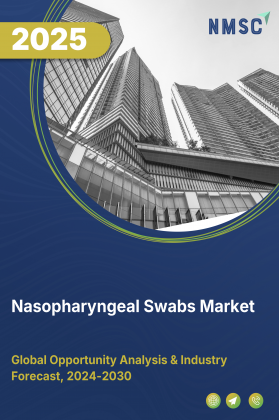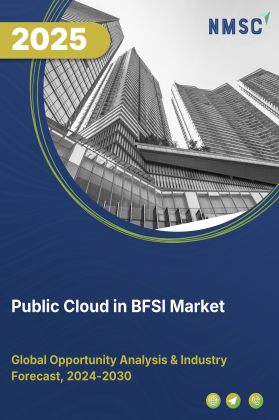
Nasopharyngeal Swabs Market by Product Type (Swabs, Transport Media, UTM/VTM Kits and Others), by Indication (COVID-19, Influenza, Respiratory Syncytial Virus (RSV), Chlamydia, Gonorrhea, and Others), by Site of Collection (Point-of-Care Collection, Home Testing, Community & Field Collection and Others), and by End User (Hospitals & Clinics, Diagnostic Laboratories and Others) – Global Opportunity Analysis and Industry Forecast 2025–2030
Nasopharyngeal Swabs Industry Outlook
The global Nasopharyngeal Swabs Market size was valued at USD 316.4 million in 2024, with an estimation of USD 337.5 million in 2025 and is predicted to reach USD 466.8 million by 2030 with a CAGR of 6.7% from 2025-2030.
The nasopharyngeal swabs industry is poised for steady growth, driven by the rising prevalence of infectious diseases such as influenza, COVID-19, and respiratory syncytial virus, which continue to highlight the critical role of swabs in accurate diagnosis and large-scale surveillance.
The increasing adoption of molecular diagnostics and rapid point-of-care testing further fuels demand, as PCR and antigen-based assays rely heavily on high-quality, contamination-free specimens. With healthcare systems shifting toward decentralized and home-based testing, the need for reliable sampling tools has intensified, while global investments in healthcare infrastructure and diagnostic capacity are expanding access to advanced testing solutions.
Together, these factors reinforce the position of the nasopharyngeal swabs market as an indispensable component of modern diagnostic practices, ensuring their continued relevance and long-term industry growth.
The Rising Incidence of Infectious Diseases Further Propels the Market Growth
The increasing prevalence of infectious diseases such as influenza, COVID-19, respiratory syncytial virus, and other viral outbreaks is significantly driving the demand for nasopharyngeal swabs as a critical tool for accurate diagnosis. With the rising threat of emerging pathogens and the spread of drug-resistant infections, rapid and reliable diagnostic testing has become essential for effective disease management.
For instance, the World Health Organization reported that seasonal influenza alone results in 3 to 5 million severe cases globally each year, leading to up to 650,000 respiratory deaths. Similarly, the COVID-19 pandemic highlighted the indispensable role of nasopharyngeal swabs in large-scale testing and surveillance programs. This growing burden of infectious diseases, coupled with the global emphasis on timely detection, continues to accelerate the adoption of nasopharyngeal swabs, making them a cornerstone of modern diagnostic practices.
Increasing Adoption of Molecular and Point-of-Care Diagnostics
The growing adoption of molecular diagnostics and rapid point-of-care testing is driving consistent demand for nasopharyngeal swabs, as they ensure accurate and contamination-free specimen collection. PCR-based and antigen-based tests for respiratory infections, including influenza, RSV, and emerging viral strains, rely heavily on nasopharyngeal swabs for precise detection.
With healthcare systems increasingly focusing on decentralized testing models such as mobile labs, home-based kits, and urgent care centers, the requirement for reliable sampling tools has intensified. This trend is further supported by advancements in molecular assay development, positioning nasopharyngeal swabs as a critical component in modern diagnostic practices.
Strengthening Global Healthcare Infrastructure Boost the Market Growth
Globally, governments and health organizations are increasing investments in healthcare infrastructure, with a strong focus on expanding diagnostic capacity and improving access to preventive care. This sustained financial commitment is driving the adoption of advanced diagnostic tools, where nasopharyngeal swabs remain essential for accurate and reliable sample collection in respiratory disease testing.
For instance, in the U.S., the Centers for Medicare & Medicaid Services projects national health expenditure to grow at an average of 5.8% between 2024 and 2033, outpacing GDP growth of 4.3%. This will raise healthcare’s share of GDP from 17.6% in 2023 to 20.3% in 2033, underscoring strong policy and financial support for diagnostics. Similar investments worldwide are expected to strengthen laboratory infrastructure and fuel steady demand for nasopharyngeal swabs.
Shift Toward Alternative Sample Collection Methods Restrain the Market Growth
A key restraining factor for the nasopharyngeal swabs market expansion is the growing preference for less invasive sample collection methods. Saliva-based and anterior nasal swabs are increasingly being adopted due to their convenience, reduced discomfort for patients, and suitability for self-testing.
These alternatives have been clinically validated for multiple diagnostic applications and offer comparable accuracy in detecting respiratory pathogens. As healthcare providers continue to move toward patient-friendly solutions, the reliance on nasopharyngeal swabs decline in routine diagnostics and mass testing programs, limiting their growth potential.
Expansion of Point-of-Care and Home-Based Testing Creates Future Opportunity
The rising adoption of point-of-care diagnostics and home-based testing offers strong opportunities for the nasopharyngeal swabs market demand. Portable diagnostic devices and rapid testing kits require accurate and cost-effective sample collection tools, where nasopharyngeal swabs remain widely used for sensitive respiratory assays.
This demand is particularly strong in rural areas and resource-limited regions, where quick detection of infections is critical for timely treatment. As global healthcare systems continue to emphasize decentralized care and preventive diagnostics, the integration of nasopharyngeal swabs into these platforms is expected to drive long-term market expansion.
Market Segmentation and Scope of Study
The nasopharyngeal swabs market report is divided on the basis of product type, indication, site of collection, end user, and region. On the basis of product type, the market is grouped into swabs including foam-tipped swabs, flocked nylon swabs, cotton-tipped swabs, and polyester swabs, along with transport media, UTM/VTM kits, and others. On the basis of indication, the market is categorized into COVID-19, Chlamydia, and others. On the basis of site of collection, the market is grouped into point-of-care collection, home testing, community and field collection, specialized institutional collection, and others. On the basis of end user, the market is grouped into hospitals and clinics, diagnostic laboratories, public health organizations, and others. Regional breakdown and analysis of each of the aforesaid segments includes regions comprising of Asia-Pacific, North America, Europe, and RoW.
Geographical Analysis
North America accounts for a substantial share of the nasopharyngeal swabs market, supported by advanced healthcare infrastructure, high testing volumes, and strong research capabilities. The U.S. remains the leading contributor, driven by widespread adoption of molecular diagnostics, preventive screening programs, and government-backed healthcare spending.
According to the American Medical Association, U.S. health spending rose by 7.5% in 2023 to $4.9 trillion (or $14,570 per capita), marking the highest growth rate since 2003, excluding the pandemic surge in 2020. This acceleration was fueled by higher utilization of healthcare goods and services and a historically high 92.5% insured share, reinforcing the steady demand for diagnostic tools such as nasopharyngeal swabs.
Europe represents a mature market characterized by strong public health systems, rising prevalence of respiratory diseases, and ongoing investments in diagnostic innovation. Countries such as Germany, the U.K., and France are at the forefront of diagnostic testing, with widespread use of nasopharyngeal swabs in hospitals, diagnostic laboratories, and research institutions.
The European Centre for Disease Prevention and Control (ECDC) continues to emphasize influenza and respiratory virus surveillance, reinforcing demand for reliable specimen collection tools. Additionally, EU healthcare modernization programs and funding for infectious disease preparedness support steady market growth across the region.
Furthermore, Asia Pacific is projected to record the fastest growth in the nasopharyngeal swabs market share, fueled by rising healthcare investments, a growing population, and the increasing prevalence of respiratory infections. Governments across the region are strengthening healthcare infrastructure and expanding diagnostic capabilities to improve disease surveillance.
As part of these efforts, the World Health Organization’s South-East Asia Regional Office recently supported a specialized training programme for Thailand’s National Influenza Centre to enhance antiviral resistance testing. The training focused on advanced laboratory techniques, including neuraminidase inhibition assays and the Influenza Replication Inhibition Neuraminidase-based Assay, equipping technicians to assess antiviral susceptibility more effectively. Such initiatives highlight the region’s emphasis on improving diagnostic capacity, thereby reinforcing demand for reliable sample collection tools like nasopharyngeal swabs.
The Rest of the World (RoW) market is experiencing steady growth in the nasopharyngeal swabs sector, driven by gradual improvements in healthcare access and the expansion of diagnostic infrastructure. In Latin America, initiatives to strengthen public health systems and enhance disease surveillance are creating consistent demand for reliable sample collection tools.
The Middle East is witnessing rising investments in healthcare modernization, with a strong emphasis on advanced diagnostic capabilities. Meanwhile, Africa is benefiting from increased international support to build diagnostic networks for infectious diseases. As accurate testing begins with proper sample collection, these developments collectively reinforce the growing adoption of nasopharyngeal swabs across the region.
Strategic Innovations Adopted by Key Players
Key players in the global nasopharyngeal swabs industry are adopting differentiated strategies to strengthen their positions. Innovation-driven companies like COPAN and BD are enhancing brand visibility through patented swab designs, automation, and self-collection initiatives, while Thermo Fisher leverages its scale and supply reliability to secure long-term contracts with health systems.
Established mid-tier firms such as Puritan, MWE, Deltalab, Starplex, and Hardy focus on operational stability, regional partnerships, and service-led engagement to retain loyal customer bases. Meanwhile, HiMedia and Miraclean target cost-sensitive markets with broad, value-focused portfolios and OEM partnerships, expanding their presence in emerging regions.
Collectively, these moves highlight a competitive landscape where premium innovation, dependable supply, and regional adaptability remain the core levers of the sustainable nasopharyngeal swabs market growth.
Key Benefits
-
The report provides quantitative analysis and estimations of the sector from 2025 to 2030, that assists in identifying the prevailing nasopharyngeal swabs market opportunities.
-
The study comprises a deep-dive analysis of the current and future nasopharyngeal swabs market trends to depict prevalent investment pockets in the industry.
-
Information related to key drivers, restraints, and opportunities and their impact on the market is provided in the report.
-
Competitive analysis of the key players, along with their market share is provided in the report.
-
SWOT analysis and Porters Five Forces model is elaborated in the study.
-
Value chain analysis in the market study provides a clear picture of roles of stakeholders
Nasopharyngeal Swabs Market Key Segments
By Product Type
-
Swabs
-
Foam-Tipped Swabs
-
Flocked Nylon Swabs
-
Cotton-Tipped Swabs
-
Polyester Swabs
-
-
Transport Media
-
UTM/VTM Kits
-
Others
By Indication
-
COVID-19
-
Influenza
-
Respiratory Syncytial Virus (RSV)
-
Chlamydia
-
Gonorrhea
-
Streptococcus & Other Bacterial Infections
-
Sexually Transmitted Infections (STIs)
-
Others
By Site of Collection
-
Point-of-Care Collection
-
Home Testing
-
Community & Field Collection
-
Specialized Institutional Collection
-
Others
By End User
-
Hospitals & Clinics
-
Diagnostic Laboratories
-
Public Health Organizations
-
Others
By Region
-
North America
-
The U.S
-
Canada
-
Mexico
-
-
Europe
-
The UK
-
Germany
-
France
-
Italy
-
Spain
-
Denmark
-
Netherlands
-
Finland
-
Sweden
-
Norway
-
Russia
-
Rest of Europe
-
-
Asia-Pacific
-
China
-
Japan
-
India
-
South Korea
-
Australia
-
Indonesia
-
Singapore
-
Taiwan
-
Thailand
-
Rest of Asia-Pacific
-
-
Rest of the World
-
Latin America
-
Middle East
-
Africa
-
Key Players
-
COPAN Diagnostics Inc
-
Puritan Medical
-
Deltalab
-
Medical Wire & Equipment
-
Becton Dickinson
-
Titan Biotech Limited
-
Wuxi NEST Biotechnology Co., Ltd
-
Thermo Fisher Scientific Inc
-
AdvaCare Pharma
-
SG Medical, Inc.
-
Formlabs
-
Hardy Diagnostics
-
GPC Medical Ltd
-
super Brush LLC
-
Cardinal Health
Report Scope and Segmentation
|
Parameters |
Details |
|
Market Size in 2025 |
USD 337.5 Million |
|
Revenue Forecast in 2030 |
USD 466.8 Million |
|
Growth Rate |
CAGR of 6.7% from 2025 to 2030 |
|
Analysis Period |
2024–2030 |
|
Base Year Considered |
2024 |
|
Forecast Period |
2025–2030 |
|
Market Size Estimation |
Billion (USD) |
|
Growth Factors |
|
|
Countries Covered |
28 |
|
Companies Profiled |
15 |
|
Market Share |
Available for 10 companies |
|
Customization Scope |
Free customization (equivalent to up to 80 working hours of analysts) after purchase. Addition or alteration to country, regional, and segment scope. |
|
Pricing and Purchase Options |
Avail customized purchase options to meet your exact research needs. |

















 Speak to Our Analyst
Speak to Our Analyst

























